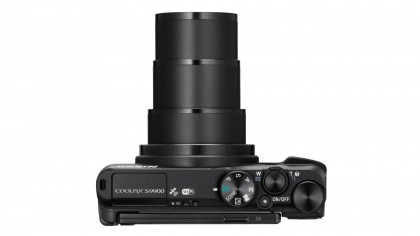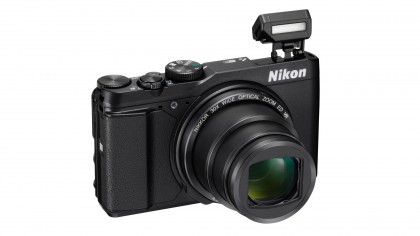TechRadar Verdict
The Nikon S9900 offers a very long zoom range in a surprisingly compact body, but there's no overcoming the limitations of the small sensor, and the image quality isn't great – you can't shoot raw files, either.
Pros
- +
30x optical zoom range
- +
Slim, lightweight yet solid build
- +
Very effective Vibration Reduction system
- +
Vari-angle LCD screen
Cons
- -
Can't shoot in raw quality mode
- -
No built-in or optional viewfinder
- -
Image quality is a little lacking
- -
LCD isn't a touchscreen
Why you can trust TechRadar
Cigarette packet slim, the S9900 is just about thin enough to slip into a spare pocket. Indeed, at 112 x 66 x 40mm (4.5 x 2.6 x 1.60-in) and 289g (10.2oz), its space-saving design and light weight are ideal for a trip around town or for jetting off to the other side of the world.
Switch it on, however, and the beast within launches out of the front of the camera – a retracting lens with a powerful 30x zoom range, equivalent to 25-750mm. It stretches all the way from generous wide-angle coverage to super-telephoto reach at the flick of the zoom lever, conventionally placed around the shutter button.


Employ Nikon's 'Dynamic Fine Zoom' (digital zoom) extension, and you can double up to a frankly monstrous 1500mm effective focal length.
The combination of svelte build and heavy-duty zoom range isn't unique. The S9900 is in direct competition with the Canon PowerShot SX710 HS, Panasonic DMC-TZ70 and Sony HX60V, all of which have 30x optical zoom lenses. The Nikon is pricier than the Sony but undercuts both the Canon and Panasonic cameras.
One thing that helps to pack a lens with such long telephoto reach into a small camera is that the image sensor is also small. It's a 16.0Mp CMOS sensor with a form factor of 1/2.3-inch and a resulting focal length multiplier of 5.6x. The actual focal length of the lens is therefore just 4.5-135mm and the image circle it needs to produce is only small.

It's not all about the lens, as Nikon has shoehorned a smart range of other fancy features into the S9900. These include built-in Wi-Fi and NFC communication, plus GPS for geotagging images. The GPS system also has the ability to literally pin your photos on a map, which you can view on the 3.0-inch 921k high-res LCD screen, complete with local points of interest. And if you're still feeling a little lost, there's a built-in electronic compass as well. The LCD itself boasts full vari-angle movement, but it's not a touchscreen.
Build Quality and Handling
Despite its small size and light weight, the S9900 feels solid and well engineered. The pocketable nature of the camera benefits from the lack of jutting protuberances like a viewfinder or hot shoe. You can also flip the vari-angle screen over and fold it into the camera, so it doesn't pick up scratches on its business side. The downside is that, without a built-in or optional external viewfinder, composing images on the screen under a glaring sun can be challenging, despite its non-reflective coating. And the lack of a hot shoe means you're limited to the tiny built-in pop-up flash, which is quite lacking in power.
Sign up for breaking news, reviews, opinion, top tech deals, and more.

Handling benefits from textured areas for the fingers and thumb of your right hand, complete with slight but effective sculpting for an assured grip. To aid stability, you'll naturally want to bring your left hand into play as well, which isn't so well catered for. The most obvious hold is to squeeze the left side of the camera between your index finger at the top and your thumb at the bottom. A problem here is that the pop-up flash falls under your finger, and it squashes down when you grip the camera, instead of remaining rigid when it's retracted.
The only other niggle with handling is that it's easy to accidentally press the Wi-Fi button with your right thumb when getting ready to take a shot, which diverts the camera onto a mission to find and connect to your smart device (a paired smart phone or tablet that you can use for camera control or sharing pictures). You then have to press the OK button to return to picture-taking mode.
PASM (program, aperture priority, shutter priority and manual) modes are made easily accessible via a shooting mode dial on the top panel, rather than being buried away in a menu system. The dial also gives direct access to a 'Smart Portrait' mode with blink-avoidance, and a crafty time-lapse movie mode. Regular movie capture is in the H.264/MPEG-4 format, at resolutions of up to 1080/25p.
A typical range of scene modes is gathered together under the shooting dial's Scene position, complete with a 'Scene auto selector' for 'intelligent' real-time scene analysis. There are also several special effects like soft, sepia, high-contrast mono and two 'toy camera' options. Overall, there's a good balance between being able to get to shooting modes and effects quickly and easily, without the controls being too cluttered.

It's the same story around the back of the camera, where there's direct access to flash, exposure compensation, self-timer and macro mode, while other shooting parameters like white balance, metering, autofocus and ISO are accessed by a simple and intuitive menu. Navigation would have been easier if the S9900 had a touchscreen but making adjustments is quite quick and painless nevertheless.
